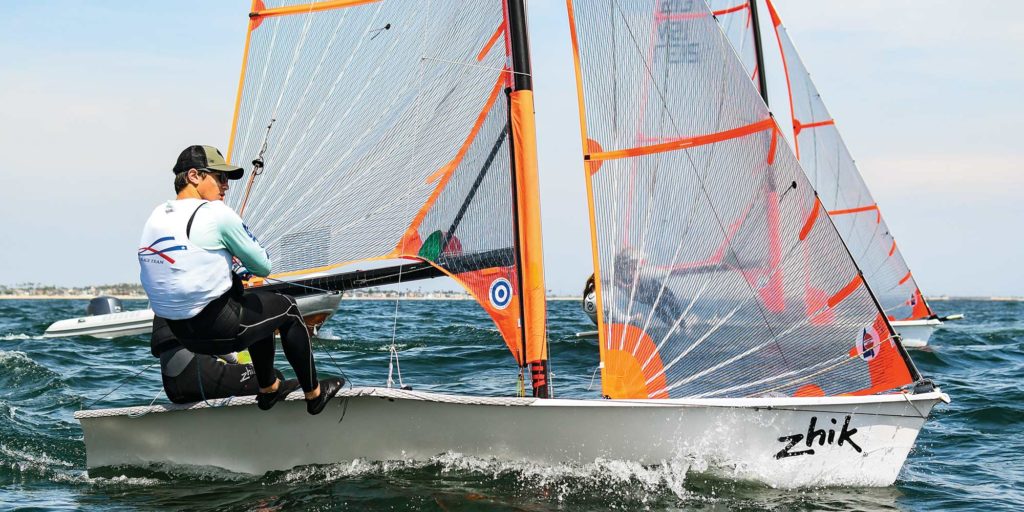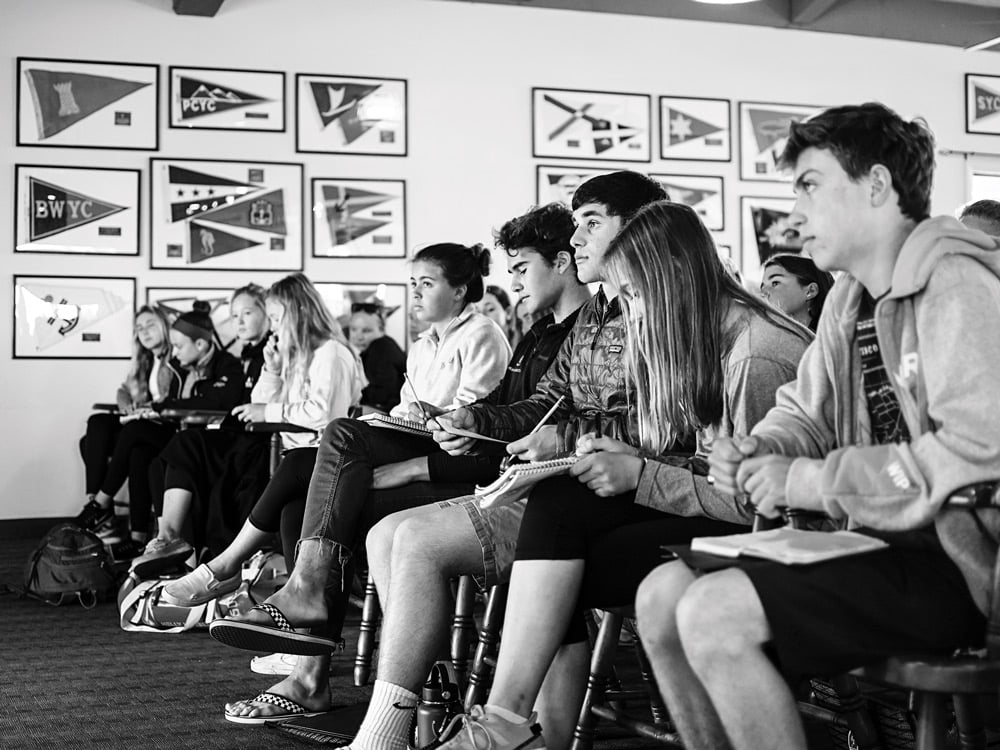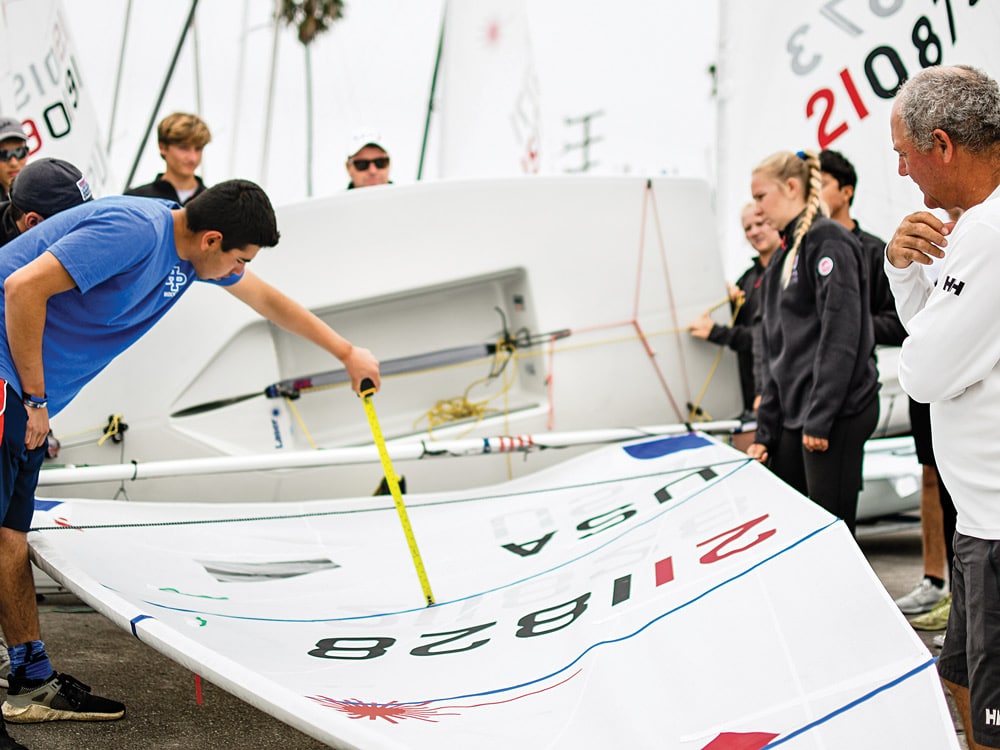
The California International Sailing Association hosted its first advanced racing clinic 40 years ago. Dave Perry and I were the coaches, asked to help aspiring young sailors improve their skills. Several sailors from that inaugural clinic went on to win Olympic medals, including JJ Fetter, John Shadden and Brian Ledbetter. Recent Olympians that attended the CISA clinic at some point early in their careers include Charlie Buckingham, Annie Haeger, Briana Provancha and Zach Railey. The clinic has continued and evolved over the years, and when I revisited the most recent one, I found it to be an impressive learning experience for the sailors, as well as the all-star roster of 19 coaches.
The clinic spans four packed days, with each day dedicated to different elements: boathandling, boatspeed, teamwork and tactics. The daily routine, which starts at 8 a.m. and runs full speed until 8 p.m., includes formal fitness training, followed by group briefings and on-the-water drills and races. Sixty-seven sailors were selected for the clinic, spread across four classes: International 420, 29er, Laser Radial and Formula Kiteboards.
“Participants need to take their sport seriously,” says clinic director Molly Vandemoer, who reviews applicants. “They must have a solid practice plan in place, goals set and a fitness regime. Our goal is to get the top sailors from across the country in one place, with excellent coaching. With a collaborative atmosphere, it’s hard not to improve over four days. We have no age limit, but most sailors are in the 13-to-18 range.”
Perry returned after his first year and served as an “at-large” coach. He is one of the most knowledgeable experts on the Racing Rules of Sailing, and a keen observer of performance. He says the types of sailors haven’t changed much over the past 40 years despite the higher levels of training we see in youth sailing today. “They are still excited to be in a situation where they are learning things about something they love and want to get better at,” Perry says. “As for coaching, the techniques haven’t changed either, except for video and other electronic equipment, which makes coaching more effective.”

At the conclusion of the first day’s drills, I sat in on the debriefs. Each coach is assigned to a specific class. The 19 coaches included National Sailing Hall of Fame inductee Dave Ullman, collegiate champion and two-time Olympian Amanda Clark, two-time Olympic medalist Charlie McKee, two-time Rolex Yachtswoman of the Year Sally Barkow, three-time Olympic medalist and Hall of Famer Mark Reynolds and America’s Cup-winning coach Grant Spanhake. Targeted details given by the coaches kept every young sailor’s rapt attention.
The Alamitos Bay Yacht Club in Long Beach, California, has hosted every CISA clinic, which was started in 1978 by Dave Crockett. Organizing an ambitious training session requires a dedicated board and staff. Mike Van Dyke is the current CISA president and says the organization has refined its focus over the past three to four years, concentrating on youth development classes, seeking out the best resources in those areas. For Van Dyke, the looming Olympic regatta in Long Beach in 2028 is having an impact.
“It is an exciting time to be living in Long Beach, and to be a sailor,” he says. “There’s no doubt some of our alumni will be sailors in the Olympics.”
The clinic’s $600 registration fees cover about half the operating costs, while the rest comes from corporate and individual donations. Van Dyke says the organization has been “blessed by having a consistent track record of producing sailors who have gone on to achieve great things. We have a diverse funding base. It’s a challenge, and we could do more and have a greater impact, but it does take funding.”
There are other advanced racing clinics elsewhere in the United States, including the Brooke Gonzalez Clinic, which is run by Sail Newport in Rhode Island, now in its 17th year. This is a bring-your-own-boat clinic, although a handful of charter boats are available. The Brooke Gonzalez Clinic also features a strong list of top college coaches and recent champions.
In Mantoloking, New Jersey, the Carl van Duyne Clinic collaborates with the CISA group. “We do compare notes with some of the other clinics around the country,” says Van Dyke. “We want to see what is happening and get a benchmark, and I think it would be great for various clinics to send their directors around the country to observe the different clinics to share ideas and best practices.”
Vandemoer says the organization invites all California junior program coaches and directors to attend the clinic and shadow the coaches as a “ride-along coach,” encouraging them to sit in on the debriefs. “It’s a fantastic way to reach as many sailors as possible,” she says.

When I was sailing in college in 1970, I was invited to an advanced racing clinic at the Hoofers Sailing Club at the University of Wisconsin, just before college nationals. There was a fleet of Lehman 12s and a fleet of Vanguard 470s. The clinic was led by two-time Olympic medalist Peter Barrett, and I remember how patient he was with all of us. The three-day clinic was invaluable throughout my college sailing career. Four years later, Sailing World sponsored a clinic at the USA Olympic Training Center on Lake Ontario.
I was the instructor. George Eddy, publisher of the magazine at the time, had organized a new fleet of 10 Lasers and 10 new 470s. Each session lasted six days. Among the young participants was Gary Bodie, who went on to be one of the most successful college and Olympic coaches in American sailing.
Inspired by my experiences, thanks to both Barrett and Eddy, I pitched US Sailing with the idea of creating a traveling advanced racing clinic. In 1975, I ran 10 clinics throughout that summer. By 1976, the clinics were so popular that we hired several more coaches from the college ranks, including Perry, Peter Isler, Stuart Johnstone, Ed Baird and Mark Laura. Every single coach had a full schedule of clinics. The idea for the CISA clinic came out of that series.
In recent years, sail training for aspiring racers has been established at several permanent facilities around the United States. Oakcliff Sailing in Oyster Bay, New York, for example, has an impressive program in a wide variety of boats. For sailing clubs looking to improve skill levels, a once-a-year three- to four-day clinic is a good way to start.
“The CISA clinic helps young sailors reach their goals by bringing in the best coaches and sailors in the country,” Perry says. “The sailors can work on their technique with the right information after the clinic. By attracting top sailors, it helps motivate and raise the bar for their own success.”
Looking toward Los Angeles in 2028, Van Dyke admits to having goosebumps, “with the thought that one of these kids in our clinic this year could be walking in the Opening Ceremonies. By helping them achieve their dreams, by showing them how to unleash their potential, it’s pretty powerful stuff.”









